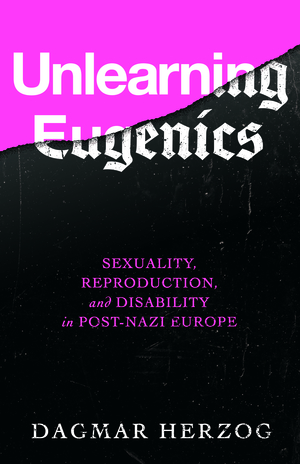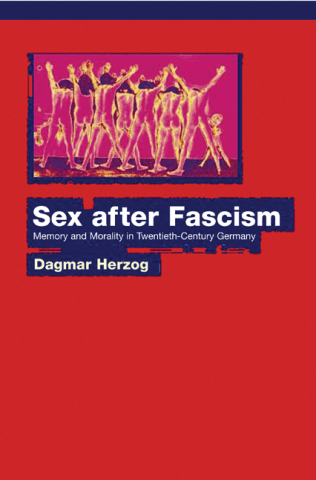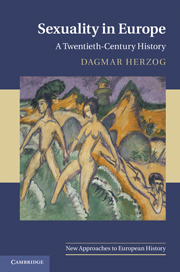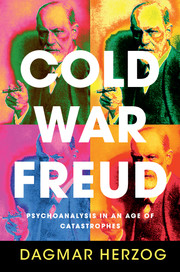Few topics are provoking dilemmas of moral argument and legal strategy more powerfully than the impasse currently evident across European nations between women’s reproductive rights and disability rights. A major new tactic of antiabortion activists and lawmakers, evident in a variety of guises depending on national context, has been to present the curtailment of abortion rights as a great advance for disability rights. These activists—many of them organized in right-wing NGOs—draw their rhetoric from the history of Nazi abuse and murder of the disabled. The lessons they draw from the Nazi past are very different from those advocated by sexual and reproductive rights activists since the 1960s. These conflicts over the meaning of the past are at the heart of my most recent book, Unlearning Eugenics: Sexuality, Reproduction, and Disability in Post-Nazi Europe.1 Madison, WI: University of Wisconsin Press, 2018More Info →
Madison, WI: University of Wisconsin Press, 2018More Info →
Unlearning Eugenics is a book about intimate human rights. Both sexual rights and disability rights were latecomers to the post–World War II human rights agenda—for a long time, neither got taken seriously—and now they are being pitted against each other. From Germany (2009), Spain (2012), and the United Kingdom (2013) to Hungary (2011), Austria (2015), and Poland (2016), abortion opponents have promoted restrictions on sexual and reproductive self-determination as justice for the physically and cognitively disabled. Abortion on grounds of fetal anomaly has become one of the most fraught areas of bioethical and political controversy across the European Union. The practical consequences of this conflict have been immense. They are being played out in the courts and the media, in parliamentary inquiries and doctors’ offices, and in countless private lives—even as austerity policies have meant that government support both for care and for the infrastructure that facilitates self-determining lives for differently abled individuals is cut and the necessary conditions for flourishing lives are concretely constricted. The present impasse in which abortion rights and disability rights in Europe are seen as competing has an important prehistory in the Third Reich.
Post–World War II indifference to Nazi crimes against the disabled
The mass murder of the disabled in Nazi Germany—the Nazis’ first systematic mass murder operation—anticipated the Holocaust of European Jewry. It involved the initially industrialized (asphyxiation in carbon monoxide–fed gas chambers, though also, in some cases, execution by shooting) and later decentralized (medication overdose, poison injection, deliberate starvation and, occasionally, mobile gas vans or, again, shooting) intentional slaughter of approximately 210,000 of the most vulnerable psychiatric patients and individuals with cognitive disabilities in Nazi Germany and Austria, as well as a further 80,000 in Nazi-occupied territories in France, Poland, and the Soviet Union. More than 120 men who had gotten their training and practice in killing the disabled moved on to Poland to run the death camps of Belzec, Sobibor, and Treblinka. Unlike the widespread moral revulsion expressed against the persecution and murder of European Jewry—although certainly postwar Europe was not free of resentment-filled antisemitism, and denialist movements rose quickly as well—the significance and effects of the killing of the disabled in the postwar world has long remained unclear.
The reality of mass murder did not lead directly into any fresh concern for disability rights or make negative attitudes toward the disabled unacceptable in the postwar era. On the contrary, and shockingly, popular hostility to the disabled was exacerbated and deepened; disability was a source of shame for families, while many of the perpetrator-doctors enjoyed great popular support and had bright postwar careers. It took a full four decades for disability rights activists to become able to shape policy in significant ways.
It therefore comes as no great surprise that negative assumptions about disability would end up also shaping the abortion discussions during the height of the sexual revolution in the 1960s. It was apparently easier for advocates across Western Europe to say that abortion should be legal because it was (supposedly) so awful to bear and raise a disabled child, than to argue comprehensively for sexual freedom and make the case that women deserve to decide about their sexual and reproductive lives. It is this insensitivity in the prochoice rhetoric of the 1960s and 1970s that has come back to haunt us in the twenty-first century—as antiabortion activists, in country after country, now style themselves as vigorous opponents of “eugenics.”
The Nazi effect on postwar sexual and gender politics
“Conservative Christians in the 1940s and 1950s argued that the Nazis had encouraged sexual licentiousness and that their sexual immorality was inextricable from their genocidal barbarism.”The long-term legacies of Nazism in post–World War II Europe have not just shaped the contemporary abortion vs. disability rights debate but sexuality and gender politics as a whole. In the 1998–1999 year, I was honored to be one of the recipients of a fellowship from the SSRC’s innovative Sexuality Research Fellowship Program (SRFP) to better understand these entanglements. In the course of that year, I undertook extensive research on the peculiar fact that in post-Nazi Germany, the lessons of Nazism and the Holocaust were worked through in the realm of sexual politics. Conservative Christians in the 1940s and 1950s argued that the Nazis had encouraged sexual licentiousness and that their sexual immorality was inextricable from their genocidal barbarism. Later, in the 1960s and 1970s, New Left and liberal activists argued exactly the opposite. They asserted that only sexual liberation would prevent another Auschwitz.
What exactly had been the relationship between pleasure and evil under Nazism? How could the restoration of “family values” have been seen as an appropriate response to mass murder—what kind of displacement of moral debate was this, and how did it work to distract attention from Christians’ own complicity in supporting Nazi policies? What did any of this have to do with the ways in which specifically Jewish activists had been at the forefront of sex rights advances in the Weimar era? And, how did the later reinterpretation of the past, linking Nazi brutality not with sexual incitement but rather pervasive sexual repression, even if it was historically false, actually help to promote causes like the decriminalization of homosexuality and liberalization of access to contraception? The book that came out of that research was published in 2005, titled Sex after Fascism: Memory and Morality in Twentieth-Century Germany.2 Princeton, NJ: Princeton University Press, 2005More Info →
Princeton, NJ: Princeton University Press, 2005More Info →
Twenty years on, I’ve worked on many other projects, several of them sequels of a sort to Sex after Fascism, growing out of questions I learned to ask during my SRFP year. How can we best understand what we might call the sex work done by the Religious Right for the Republican Party in the United States in the 1990s and 2000s?3Dagmar Herzog, Sex in Crisis: The New Sexual Revolution and the Future of American Politics (New York: Basic Books, 2008). What do we gain when we use a comparativist approach—across 25 countries and 100 years—to explain how sexual cultures go in either liberal or conservative directions?4 New York: Cambridge University Press, 2011More Info → What happens when we explore the historical relationships between desire, trauma, and aggression in the postwar world from the perspective of psychoanalytic theory?5
New York: Cambridge University Press, 2011More Info → What happens when we explore the historical relationships between desire, trauma, and aggression in the postwar world from the perspective of psychoanalytic theory?5 New York: Cambridge University Press, 2016More Info → And how did the LGBT movements of the 1980s and 1990s help to prepare the ground for the so long delayed but ultimately successful rise of disability rights?
New York: Cambridge University Press, 2016More Info → And how did the LGBT movements of the 1980s and 1990s help to prepare the ground for the so long delayed but ultimately successful rise of disability rights?
The movements for LGBT and disability rights
For as it happens, the LGBT rights movements of the 1980s and 1990s, both in the United States and across Europe, have been incredibly significant for preparing a strong case for disability rights. They have modeled imaginative new ways to engender empathy and to communicate both the universally relevant implications and the minoritizing aspects of differently abled life—whether emphasizing the beauty of nonnormative bodies or the ways disability, because it causes such intricate interdependencies between people, inevitably reconfigures families.
In the meantime, the collapse of communism and the unification of Europe also brought novel complications, as fiercely nationalist and aggressively sexually conservative versions of Christianity—hostile to abortion and homosexuality alike and positioning themselves against the purported licentiousness of the post-sexual-revolution West—were newly in the ascendant. Unexpectedly, the terms in which the multidecade battles that had been fought in Western nations to get both women’s rights to reproductive self-determination and the securing of dignity and rights for individuals with disabilities understood as postfascist moral imperatives were scrambled by the very different conclusions drawn in Eastern bloc nations about what would constitute appropriate postcommunist lessons.
Pasts and presents were suddenly ricocheting wildly—and those ricochets became part of what I write about. In the course of the research for Unlearning Eugenics, among the most precious findings I encountered in the archives were a vital handful of intentional life-sharing communities, bringing together disabled and abled individuals, founded already in the 1940s, 1950s, and 1960s by opponents of or refugees from Nazism, in deliberate reaction against the National Socialists’ mass murder project. Some of them exist to this day, now dispersed across dozens of nations. Studying these communities showed me that there have been other ways to unlearn eugenics in post-Nazi Europe—and bringing these into view has helped me think about ways of living that hold valuable promise for the future as well.














